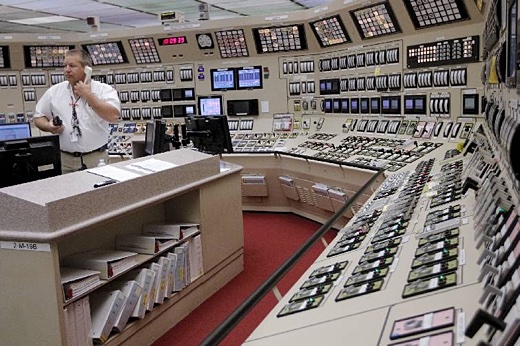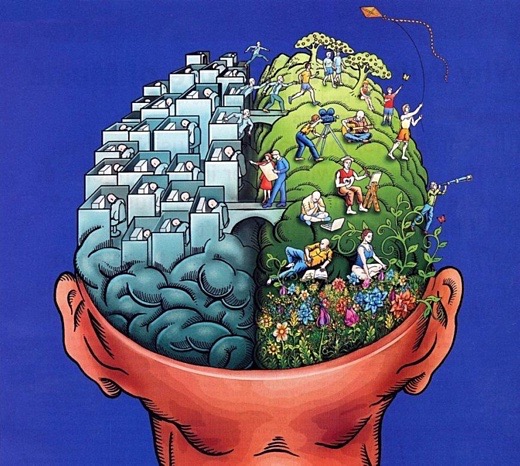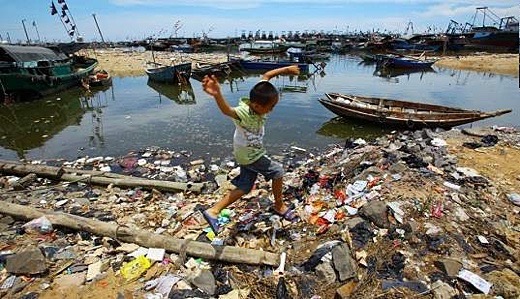SOURCE: Andy Kass (
a_kass@yahoo.com)
SUBHEAD: Vietnam's low-tech food delivery takes advantage of decay and fermentation.
By Aaron Vansintjan on 20 February 2017 for Low Tech Magazine -
(
http://www.lowtechmagazine.com/2017/02/vietnams-low-tech-fermentation-food-system-takes-advantage-of-decay.html)
 Image above: A stall selling homemade dưa chua in a Hanoi market. Photo by Aaron Vansintjan From original article.
Image above: A stall selling homemade dưa chua in a Hanoi market. Photo by Aaron Vansintjan From original article.
The food system in the industrialized world is based on mass-production, global distribution, and constant refrigeration. It requires many resources and produces a lot of food waste.
In a tropical climate, everything decays faster. Bread gets soft and mushy, milk spoils, the walls get moldy just months after a layer of fresh paint. Food poisoning is a constant concern. The heat and moisture make for an ideal breeding ground for bacteria and fungi.
In this environment, you’d think people would be wary of any food product that smells funny. But in tropical Vietnam, food can get pretty pungent.
Take
mắm tôm, a purplish paste made of fermented pureed shrimp. Cracking open a jar will result in a distinct smell of ‘there’s something wrong here’ with hints of marmite to whelm through the whole room. You have
chao, a stinky fermented tofu, which was so rank that the smallest bite shot up my nose and incinerated my taste buds for an hour (‘Clears the palate!’ said the waiter encouragingly).
Consider
rượu nếp, which is sticky rice mixed with yeast and left to ferment for several days ‘in a warm place’ — i.e. the counter.
The result is a funky-smelling desert—literally rice left to rot until it turns in to a sweet wine pudding. On the 5th of May of the lunar calendar, Vietnamese people will eat
rượu nếp in the morning to celebrate ‘inner parasite killing day’. Bonus: day-drunk by the time you arrive at work.
We shouldn’t forget Vietnam’s world-famous fish sauce —
nước mắm — made from diluted fermented fish, a flavour that many people around the world continue to find totally intolerable.
In Vietnam, putrefaction is accepted as a part of life, even encouraged. But fermentation in Vietnam isn’t just an odd quirk in a tropical diet.
To understand why fermentation is so integral to Vietnamese culture, you have to consider how it is embedded within people’s livelihoods, local agricultural systems, food safety practices, and a culture obsessed with gastronomy; where food is seen as a social glue.
And when you bring together all these different puzzle pieces, an enchanting picture emerges: one in which fermentation can be a fundamental component of a sustainable food system.
Unlike many high-tech proposals like ‘smart’ food recycling apps, highly efficient logistics systems, and food packaging innovations, fermentation is both low-tech and democratic—anyone can do it. What’s more, it has low energy inputs, brings people together, is hygienic and healthy, and can reduce food waste.
Rotting Food can be Safe and Healthy
At the entrance of a market in Hanoi, a woman with a
dưa chua stand tells us that making ‘sour vegetables’ is easy: you just add salt to some cabbage and let it sit for a couple of days. As we talk, several customers come by, eager to scoop some brine and cabbage into a plastic bag. Worried that we’re discouraging her customers, she shoos us away. She isn’t lacking business.
Is fermentation really so effortless? The short answer is yes. Many recipes will call for two things: water and salt. At just a 1:50 ratio (2%) of salt to food, you can create an environment undesireable for all the bad bacteria and encourage all the good ones. Sauerkraut, kimchi, fish sauce, sriracha, and kosher dill pickles—are all made according to this principle.
Yet other types of fermentation are a bit more complicated. They call for sugar (e.g. wild fermented alcohol like ethiopian honey wine), yeast starters (
rượu nếp, most wines and beers), special fungi (tempeh, miso), or some kind of combination of fungi, bacteria, salt, or sugar (kombucha).
Yet others are simpler: to make cooking vinegar, just let that bottle of bad wine sit for a couple of days, and to make sourdough, just mix water and flour and leave it on your counter.
All in all, fermentation is just controlled decay: your most important ingredient is time. This can sound like a bit too much, too fast. Take the woman I met at the entrance of the market. Her
dưa chua, while in great demand, looks like wilted cabbage, soppy, floating in murky brine.
Some bubbles are forming on the edges of the plastic container—for the trained eye a sign of an active fermentation process, but for the uninitiated, an alarm bell.
There’s no use beating about the bush. That
dưa chua is in fact rotting in a very similar way that a peat swamp is constantly rotting, belching large doses of methane into the world. What’s happening is an anaerobic fermentation—that is, without significant amounts of oxygen.
This absence of oxygen and the high levels of salt creates an environment supportive to several bacteria that also find their home in our own digestive systems.
Those bubbles forming in the container are by-products of these bacteria: CO2 and methane. The bacteria also lower the pH and start breaking down raw food—essentially pre-digesting it for you.
And, once the pH goes down even lower, you’ve created a monster so voracious that no other fungus, bacteria, or parasite with bad intentions will dare to enter its domain. So yes, it’s rotting just like a stinky swamp, and that’s a good thing.
 Image above: A woman sells nem chua — raw fermented pork—outside her house. Photo by Aaron Vansintjan From original article.
Image above: A woman sells nem chua — raw fermented pork—outside her house. Photo by Aaron Vansintjan From original article.
It’s a good thing especially in a climate like that of Vietnam. Every fermentation is a small victory against the constant war against heat and humidity, which destroys all edibles in its path.
Instead of eating raw cabbage and risking death by a thousand E. Coli, you can eat fermented cabbage and know, for a fact, that it won’t have you hunkering by the toilet bowl any time soon.
Not only that, but eating fermented food has significant health benefits. You might’ve noticed the new fad of ‘pro-biotic’—well all that really means is that the product contains some kind of active bacterial culture that looks like the flora in your own stomach.
That would include, not just Go-gurt, Yoplait, Chobani, and Danone, but also several kinds of cheese, pickles, beer, and just about any other fermented product.
Eat about a tablespoon of any of these at the end of every meal, and you inoculate your stomach with a fresh batch of microbes that help you digest—all the more necessary when we eat antibiotics in our meat and bland diets of white bread and peanut butter, and drink chlorine in most municipal water systems.
Further, products like fish sauce and shrimp paste provide many impoverished Vietnamese with micro-nutrients, B-12 vitamin, proteins, and omega 3 fatty acids—comprising a significant part of people’s nutritional requirements. For a country that still remembers hunger and starvation, this is no small fry.
After several months of studying Hanoi’s food system and the people who make their living off of it, Vân (my Vietnamese collaborator) and I are starting to see some patterns.
A Diverse Food System
In the same market we talk to a vegetable vendor. Real estate in the neighborhood is getting more expensive, rents are going up. She’s having a hard time making ends meet.
On her street many elderly have sold their farmland—which they used to grow vegetables and decorative flowers—and now, unemployed, they spend their time selling home-made fermented vegetables out of their front door.
In the same neighborhood, we meet Tuan, an elderly woman growing vegetables in the banks of a drained pond. She rarely goes to the market—she can grow much of her own food in this little patch. We ask her if she ever ferments her vegetables.
Of course, but she doesn’t sell them—they’re just for herself and her family.
After several months of studying Hanoi’s food system and the people who make their living off of it, Vân (my Vietnamese collaborator) and I are starting to see some patterns.
In Western countries, the food system is shaped a bit like an hourglass: industrial farmers send their food to a supplier, who then engages with a handful of supermarket companies, who then sell to consumers.
In Vietnam, on the other hand, it looks more like an intricate web: wholesale night markets, mobile street vendors, covered markets, food baskets organized by office workers with family connections to farmers, guerilla gardening on vacant land.
Food is grown, sold, and bought all over the place, and supermarkets are just a small (albeit growing) node in the complex latticework. Most people still get food at the market, but many also source their food from family connections.
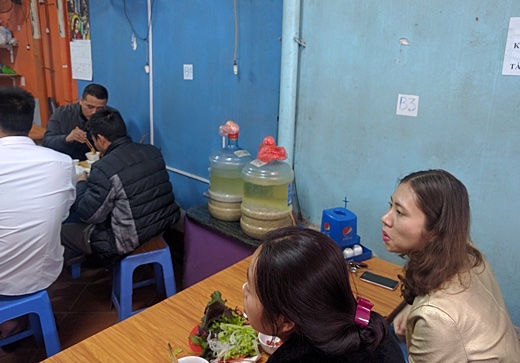 Image above: From jugs a restaurant offers home brewed rượu men, Vietnamese rice wine. Photo by Aaron Vansintjan From original article.
Image above: From jugs a restaurant offers home brewed rượu men, Vietnamese rice wine. Photo by Aaron Vansintjan From original article.
In Vietnam, many people might have one ‘profession’, but when you ask a bit more questions it’ll turn out that they have half a dozen other jobs for ‘extra income’. There’s a generalized ‘hustle’: everyone is a bit of an entrepreneur.
After talking with Tuan for several hours, we learned that she has, throughout her long life, fished, grown vegetables, corn, and fruit trees, sold rice noodles, bread, ice cream, roses, and silk worms. Now, aged 68, she grows decorative peach trees and grows vegetables when she can.
With an economy just decades shy of a highly regulated communist regime where the only food you could get was through rations, and the memory of famine still fresh in people’s mind, this is entirely understandable: with a finger in every pot, you can just about manage to survive. These two factors, a highly distributed food system and diversified livelihoods, make for a fertile environment for fermentation practices.
With easy access to wholesale produce, many can turn to small-scale fermentation to compliment their income—or, in the case of Tuan, to spend less on food at the market.
Preserving the Harvest, Bringing People Together
Vietnam hosts both the Red River delta and the Mekong delta—two of the most productive agricultural regions in the world. The heat and the vast water supply allow some areas of Vietnam to have three full growing seasons.
That means three harvests, and that means lots of food at peak times, and sometimes so much that you can’t eat it all. That’s another bonus of fermentation: if your food system is local, you’re bound to stick to seasonal consumption.
But by fermenting your harvest you can eat it slowly, over a long time period. It’s this principle that underlies much of fermentation culture in East Asia.
Take kim chi, a spicy fermented cabbage from Korea. Traditionally, the whole village would come together to chop, soak, salt, and spice the cabbage harvest every year. Then, these mass quantities of salted spicy cabbage were stored in large earthenware pots underground—where cooler temperatures lead to a more stable fermentation process.
As a result, you can have your cabbage all year. If you want a localized food system, you need to be able to store your food for long periods. Fermentation makes that possible.
Fermentation is also social. Fermenting large batches of summer’s bounty typically requires hours of chopping—the more the merrier. And chopping is the perfect time for sharing cooking tips, family news, and the latest gossip. In South Korea, now that kim chi production has been largely industrialized, people try to relive the social aspect of making it through massive kim chi parties in public spaces.
In a country like Vietnam, where a traditional food system still exists for a large part, fermentation remains embedded in social relations. Relatives and neighbors constantly gift each other fermented vegetables, and many dinners end with a batch of someone’s home brewed rice wine—rượu men. Fermentation lends itself well to a gift economy: there is pride in your own creation, but there is also no shame in re-gifting. And because of its low costs, anyone can take part in it.
Gastronomy, Tested with Time
It is a bit disingenuous to caricature Vietnam’s food culture as obsessed with rotting, and suggest that this is largely the result of a tropical climate. Rather, what we’re dealing here is difference in taste: what may seem strange and pungent to one culture is highly appreciated in another.
In fact, one of the greatest impressions I have of Vietnamese culture is its deep appreciation for gastronomy: subtle, complex flavors, considered textures, modest spicing and well-balanced contrasts define Vietnamese cuisine.
Fermentation is a crucial part of this culture: the art of fermentation requires paying attention to how flavours change as food transforms, understanding these chemical shifts and using them to achieve a desired affect.
It’s also clear that Vietnamese gastronomy is popular: it takes place in street food stalls, run by enterprising matriarchs, constantly experimenting with modern products and traditional flavors. It is cheap and, to ensure customer loyalty, it is surprisingly hygienic.
Street vendors rarely have fridges, nor do they have large cooking surfaces, dishwashing machines, or ovens. By and large, they make do with some knives, two bowls to wash fresh vegetables in, a large pot, a frying pan, coals or gas burners and — for products that may go bad during the day — fermentation. Having limited access to capital and consumer electronics, these vendors — most often women — ply their trade in a way that has stood the test of time.
They know the rules of hygiene and food safety, and, because they have to be careful with their money, they know exactly what kinds of food will go bad, and what kinds of food can be preserved.
In doing so, they practice a food culture that has been passed down through generations—to a time before fridges, a global food system powered by container shipping, factory trawlers, and produce delivered to far-off markets by airplane.
While modern technology has provided many benefits for our diets, there are many innovations from the past that have been abandoned as the global food system was transformed by the availability of cheap fuel. One such innovation was the
fish sauce industry that flourished during Ancient Roman times.
For Romans, fermenting fish was a crucial aspect of a low-tech and seasonally-bound food system. In fact, it so happens that research now suggests Vietnamese fish sauce may actually have its origins in the Roman variant produced over 2,000 years ago.
Today, however, fermentation doesn’t fit so easily within the global food system. Harold McGee at Lucky Peach tells the story of how canned products were notoriously difficult to transport in the newly industrialized food system of the 19th century.
Apparently, until the 20th century, metal cans would regularly explode, sending shrapnel and preserved tuna flying through the decks of transport ships. This was due to heat-resistant bacteria, which continued fermenting the product long after it was heat-treated.
The solution was to subject the canned product to high temperatures over a long period of time, killing all remaining cultures, in turn changing their flavor. But in the case of fermented food, the problem has not gone away: if you want it to be actively fermenting, transporting it will risk explosions on the high seas. But heating stops the fermentation process, and kills its unique flavor.
It’s for this reason that products like kim chi, kombucha, and sauerkraut often have to be produced locally, despite increasing global demand. In some way, fermentation belies the industrial food system: the fact that it is alive means that it doesn’t quite fit in. You either have to kill it, thereby change it, or it will keep bubbling through the cracks.
A Low-tech Food System is Possible
Fermentation cultures in Vietnam give us a glimpse of what an alternative food system might look like, one that is both decentralized and doesn’t depend on high inputs of fossil fuel energy to preserve food, high waste, and high-tech. Why does this matter? Well, in a world facing climate change, we need a low-impact food system, and fast.
But there are other reasons: with increasing concern over the health side effects of common chemicals such as BPA, found in almost all cans and pasta sauce jars, people are looking to safer kinds of preservation, which aren’t killing them and their families slowly.
And with the rise of the local food and food sovereignty movements, many are realising that we need food systems that support everyone: from small farmers to low-income families.
Because of its low investment costs, fermentation lends itself well to supporting small businesses, allowing them to take advantage of seasonality while practicing a time-tested low-tech method of food preparation. Today, in response to increasing food insecurity, we are hearing increasing calls for a smarter, more efficient food system.
Proposals such as intensive hydroponic and vertical farming, big data-powered logistics systems, smart agriculture technologies, and food waste recycling apps clog the news.
But we already have a low-tech innovation that works very well. Fermentation, because it is accessible to everyone, because of its low energy requirements, and because it fits right in to a more sustainable food system, should not be abandoned in the search for global food security.
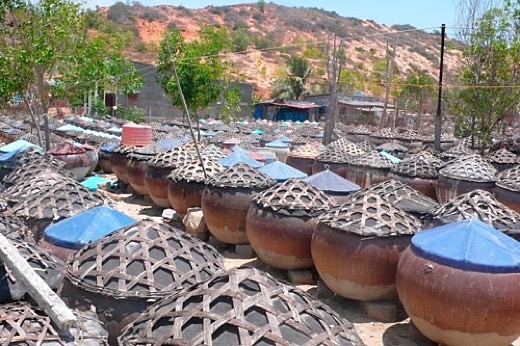 Image above: A fish sauce factory in Vietnam. Photo by Mui Ne info & events. From original article.
Image above: A fish sauce factory in Vietnam. Photo by Mui Ne info & events. From original article.
It’s easy to get the impression that we live in a world of scarcity, where there just isn’t enough food to go around, and food production all around the world is limited by technological backwardness. On the other hand, many of us are more and more concerned with the increasing problem of food waste in Western food systems.
We seem to live in a world of both scarcity and abundance at the same time.
Food fermentation is a strange thing: it inverts what many regard as waste and turns it into a social, living, edible object. As a friend of mine once said, if you have too many grapes, you make wine. If you have too much wine, you throw a party. If you still have too much wine, you make vinegar.
Fermentation turns scarcity and abundance on its head, belying easy categories of what is waste and what is too much.
Sustainability advocates worry a lot about making the ‘supply chain’ more ‘efficient’ — that is, increasing profits margins while making sure all food reaching consumers in a perfectly fresh state.
Instead, we could consider taking advantage of decay. This isn’t hard: you just have to add some salt and water. We’ve done it for thousands of years, and, if we follow the example of food cultures like those in Vietnam, we can do it again.
.









